Guide
to
St.
Servatius Catholic Church Berge
The
information below is a translation of the German from
the booklet available in St. Servatius.
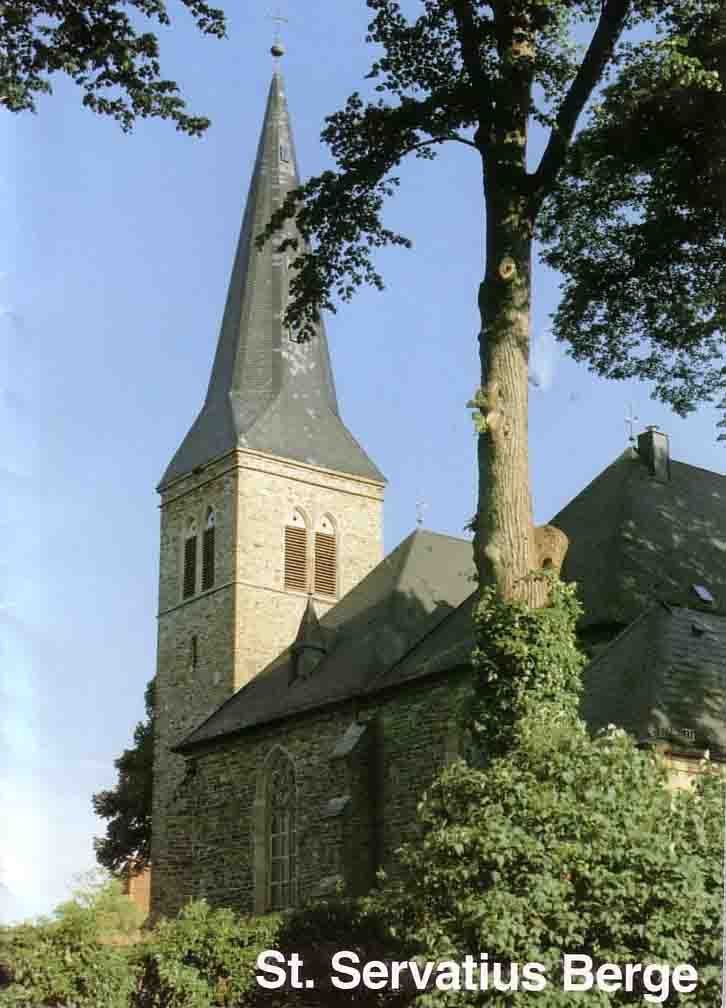
Generally
Berge,
in the far Northwest of the old sovereignty and present district
of Osnabrück, owes its charming landscape position to the
last branches of an ice age moraine elevation, which here reaches
a height of 100 meters. The pastorate church of St. Servatius
sits on a flattened plateau.
History
The
church was created around 1180 as the personal church of Count
Simon of Tecklenburg. The counts of Tecklenburg had spread out
their territory this far in the 12th century. In 1250 we learn
of the first clergyman in Berge. In the first half of the 13th
century the bishop of Osnabrück elevated St. Servatius to
a parish church; the territory was branched off from the original
parish of Bippen. Next to the village of Berge, it included the
peasants of Anten, Dalvers, Grafeld and Schmone.
The
church belonged, as did the neighboring parish, to the archdeacon
(district supervision) of the Osnabrück cathedral cantor.
After the institution of the deanery in the 17th century, Berge
is within the deanery of Fürstenau.
During
the time of the reformation and counter-reformation these was
also in the area of Berge a many sided change of religions [confessions].
Only in the year 1650, after the Thirty-year War, were the conditions
finally settled. One reached back to the circumstances of the
so-called “normal year” 1625. As in many communities
the circumstances were not possible to reconstruct exactly and
in such cases a very special regulation arrangement was chosen.
Thus one applied in Berge parish church the Catholic religion,
while in Venne the church maintained the Lutheran religion.
The
other religions certainly had freedom of belief, but were strongly
bound to the local parish church. The Evangelic Christians [Lutherans]
in Berge turned to the cathedral of Börstel, 5 km away. Only
after the change of government of Osnabrück to Hannover could
the Lutherans in Berge create their own parish church, for which
building began in 1836.
In
the year 1910 the curate Garfeld was separated out. About 1800
members belong to the present parish, which includes members from
Bippen and Manslage.
These
are the priests of St. Servatius:
1250
Albero
1306 Rodolfus
1576 – 1594 Niemann, Georg
1594 – 1605 Hüls, Laurentius
1605 – 1643 Hector, Johannes
1643 – 1652 Offermann, Ivo
1652 – 1668 Steinken, Egbert
1668 – 1691 Elmendorf, Johannes Arnold
1691 – 1692 Sterenberg, P. Christoph OP
1692 – 1713 Hamm, Lambert
1714 – 1745 Arkenow, Werner
1746 – 1769 Willebrand, Hermann Heinrich
1785 – 1817 Leeve, Lambert
1817 – 1849 Völker, Eugen
1849 – 1857 Schulte, Anton
1857 – 1885 Heilmann, Ludwig
1885 – 1888 Fährnmann, Bernhard (Pfarradmin.)
1888 – 1890 Zuhöne, Hermann
1890 – 1907 Ruiter, Bernard
1908 – 1916 Stroetmann, Bernhard
1916 Rosken, August (Pfarradmin.)
1916 – 1927 Drexler, Josef
1927 – 1953 Stöckmann, Hermann, genannt Leusing
1953 – 1968 Struve, Fritz
1968 – 1980 Dotzler, Richard
1980 – 1985 Teuber, Günter
seit 1985 Flohre, Lothar
Exterior
The
approach to the church from the main road past the impressive
framework lets you imagine something of the former defense character
of the church. On the east and west sides of the church yard there
are still remnants of walls kept as ruins, which formerly marked
boundaries of the church land. Even in the 1879 volume 6 of Mithoff’s
“Art Memorials and Antiques in the Hannover Area”
, Mithoff speaks of two spike-shaped towers which lead south and
west in the reach of the church which also was used as a cemetery.
Just behind the choir and in a separated corner of the present
area are still some noticeable grave markers and memorials remaining
from the 18th and 19th century. The greenery frames the view of
the house of God which in its present form originated in two different
epochs.
The
original form of the gothic church is still recognizable in the
west tower and the connecting westerly beam. Up to the first ledge,
the tower shows its original unstructured form, in the lower third
the sandstone wall is built with powerful remains. The openings
in the tower resemble gun placements and they indicate the defense
character of the earlier construction. In the ground plan it is
noticeable that the tower is slightly angled, as is a ship. The
arched sound openings starting directly over the fist ledge originated
from the widening of the church between 1900 and 1903. It follows
a further circular ledge and shortly over it the similar protruding
endings. The spire follows in the form of the gothic prior building:
a square that changes into an octagon. The three steel bells of
the tower (c’ – f’— as’) were delivered
in 1922 from the bell foundry Ulrich and Weule in Bockererm.
The
western beam bordering on the tower remains the closest to its
original form. Diagonally placed triple stepped buttresses capture
the thrusting vault at the corner. Under the great gothic multiple
window, the former spire-shaped south portal is still recognizable,
which at the old view disappears behind a porch. This view also
shows the original size of the window.
Both
the connecting arches were broken into in 1901 at the construction
of side naves, at the eastern walls of the former straight closed
choirs. The built-on choir room had a 5/8 closure. All windows
show rich faceted three part inlays. Both the side nave arches
have shortened slate roofs with a small core of roof. The Osnabrück
architect Alexander Behnes carried out the enlargement. The sandstone
material used – of course without mixture of left-overs
– suites well the previously found material; also the buttresses
are suiting in form and placement to the existing ones, so that
in spite of the 600-years of difference, a uniform working body
of a building lies before us. The construction of the church together
with the dedication of the new high altar was completed on September
3, 1903 by Bishop Hubert Voss with great participation of the
entire community. In the Reliquien of this altar rest the relics
of St. Gemellius and St. Micinus.
Interior
 Both
of the side nave portals lead to the interior of the church (to
the south “Berge side”, to the north “Antener
side”). The inside of the tower is a covered barrel arch
that includes the three ridges of the central nave of the former
long hall. Broad transverse arches separate them from each other.
The four respective sandstone ribs of the cross arch are fluted,
deeply carved, and resting on small corner supports. In the apex
of the arch, the ribs meet in small end stones. The side nave
arches, which are only half as wide and therefore shaped in right
corners, were added in the construction of the central nave. Also
the wall breaks through the former outer wall take up the spire
arch. Both
of the side nave portals lead to the interior of the church (to
the south “Berge side”, to the north “Antener
side”). The inside of the tower is a covered barrel arch
that includes the three ridges of the central nave of the former
long hall. Broad transverse arches separate them from each other.
The four respective sandstone ribs of the cross arch are fluted,
deeply carved, and resting on small corner supports. In the apex
of the arch, the ribs meet in small end stones. The side nave
arches, which are only half as wide and therefore shaped in right
corners, were added in the construction of the central nave. Also
the wall breaks through the former outer wall take up the spire
arch.
Choir
room formation
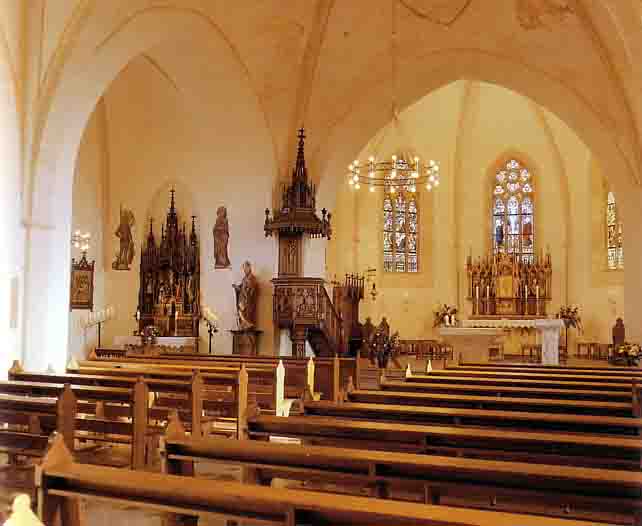 In
the course of the total interior renovation of 1992/93, the choir
room on the ground floor was formed entirely new. In
the course of the total interior renovation of 1992/93, the choir
room on the ground floor was formed entirely new.
The
step construction was drawn forward out over the triumphal arch.
The first wider “Communion Step” carries also the
pulpit from 1901. Before the beautiful middle choir window stands
the old high altar torn from the wall on an added step surface.
This serves now with the old tabernacle as repository for the
Sacrament.
Altar
and Ambo, made by the sculptors Michael and Christof Winkelmann
from Möhnessee, stand in the central area of the choir room.
They are cut out of massive sandstone in yellow-gray color brought
from Mainfranken. Altar and Ambo fit in form also very well with
the Gothic room.
The
new altar does not take up much room because of its narrow shape.
The motif of the Tree of Life is the centerpiece of the altar.
Bishop Theodor Kettmann placed relics of St. Boniface and St.
Maria Goretti in the Reliquien below the new celebration altar
at the rededication of St. Servatius and the consecration of the
altar on April 3, 1993.
The
seats of the priest and mass servers were finished in oak wood
and are movable so they can be rearranged for different liturgical
holidays. In tone of color they are indistinguishable from the
new gothic choir seats.
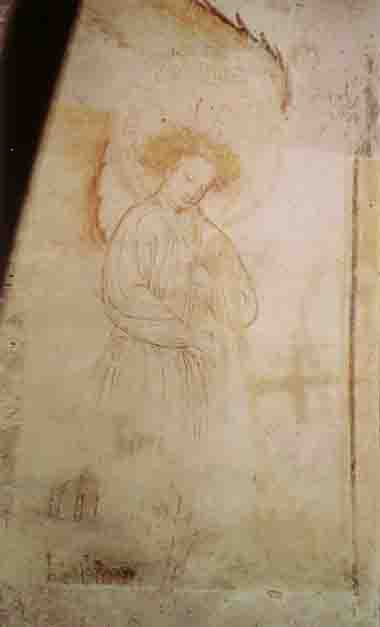 Highlights
of the medieval times are the frescos of the former choir arch,
on the east arch of the church, which were uncovered in 1992.
The now visible painting originated in the 15th century. The fresco
was covered by a one-colored arrangement of the 20th century,
a colorful painting from 1903, the Boroque painting of the 18th
century in blue and bright gray and the gray Renaissance painting
of the second half of the 16th century. Highlights
of the medieval times are the frescos of the former choir arch,
on the east arch of the church, which were uncovered in 1992.
The now visible painting originated in the 15th century. The fresco
was covered by a one-colored arrangement of the 20th century,
a colorful painting from 1903, the Boroque painting of the 18th
century in blue and bright gray and the gray Renaissance painting
of the second half of the 16th century.
Presently
manifold scenes of the theme “Last Judgement” are
shown to the visitor.
Next
we are considering the east top of the arch (toward the altar):
Christ as world judge at the Last Judgement is accompanied by
Mary and John the Baptist in penitents garb. Small human figures
are to be found in the folds of the arch.
The
south top (right) represents the condemned, who are lead by the
devil into the jaws of hell. Interesting are the different details
showing a “candidate for hell” with a money belt and
liquor bottle shown with the greedy one and drunkard.
At
left in the northern top one recognized the chosen ones before
the gate of heaven as well as sun, moon and stars. The “Heavenly
Jerusalem” was projected in the erstwhile time; it shows
gothic forms of building with multiple work windows. In the easterly
spandrel is recognized a musician angel, which also shows John
the Evangelist.
The
west top (in the direction of the organ) shows a kneeling man
(son of Elias: Elias leaves his student Elias his coat behind),
above him diagonally placed is a two-wheeled cart. At both sides
we find again musician angels, and incorporated here the evangelists
Mark and Luke. In the south spandrel one recognized upstanding
bodies, in the direction of a closing stone a closely pressed
group of angels.
Not
all entities could be described here, for the patient observer
there is still much to be discovered. Further paintings were found
in the old west arch of the church, however they were only marginally
preserved and therefore had to be covered again.
Equipment
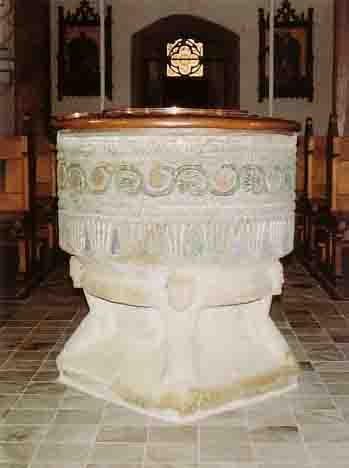 The
oldest piece of equipment of the church is the baptismal font
of the Bentheimer type, today placed in the middle nave area.
These baptismal fonts were produced in Bentheim and Gildenhaus
from the sandstone that occurs there and about 100 examples remain
in northwest Germany and the Netherlands. One can date them in
the late Roman time (shortly after 1200). The baptismal font at
Berge has special meaning because of the still partially recognizable
colored style. The
oldest piece of equipment of the church is the baptismal font
of the Bentheimer type, today placed in the middle nave area.
These baptismal fonts were produced in Bentheim and Gildenhaus
from the sandstone that occurs there and about 100 examples remain
in northwest Germany and the Netherlands. One can date them in
the late Roman time (shortly after 1200). The baptismal font at
Berge has special meaning because of the still partially recognizable
colored style.
The
basin – it is so large because in the Middle Ages the children
to be baptized were immersed – rests on four crouching figures
of men that are tied together in a ring. They could represent
the unredeemed people, while the figure vessel that crushes them
can symbolize the life outside of the grace of Baptism. In the
lower region are recognizable palm motifs, which a grapevine which
circles around the basin, alternately one recognized leaves and
grapes. The rope ornament pictures again the upper end.
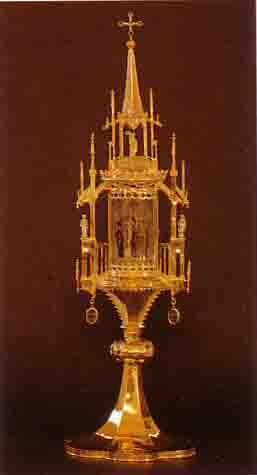 Doubtless
the old and valuable monstrance (Tower Monstrance) along with
the baptismal font, belongs to the historically valuable parts
of the church treasure. Doubtless
the old and valuable monstrance (Tower Monstrance) along with
the baptismal font, belongs to the historically valuable parts
of the church treasure.
Unfortunately
the original source of the Berge monstrance could no longer be
determined. We know however, that this worthy monstrance was constructed
in the year 1909 by the court appointed gold and silver works
of I.C. Osthues from Münster from two older monstranses,
into an artful and delicate goldsmith work.
The
remaining equipment of the church originates from the time around
1900, therefore the epoch of the widening of the church. The church
remains largely intact and deserves consideration. The church
is from the time of the new gothic style, which revealed an independence
of style that is much valued.
Altars,
chancel, choir seat and confessional seats are constructed of
wood and show the typical elements of gothic style – high
spire reliefs filled with multiple work, slim branches (small
towers) which are covered with scrawls and end in a flower cross.
The
panel painting of the Stations of the Cross, with new gothic wooden
framing, stand with their ornamentally shaped background in the
tradition of the so-called Nazarener. The tower hall was proved
with an impressive Pieta (Sorrowful Mother) on powerful sandstone
pedestal in the Chapel of Mary. It carries the inscription “Oh,
all of you who pass by her pay also attention and show a pain
similar to my pain.”
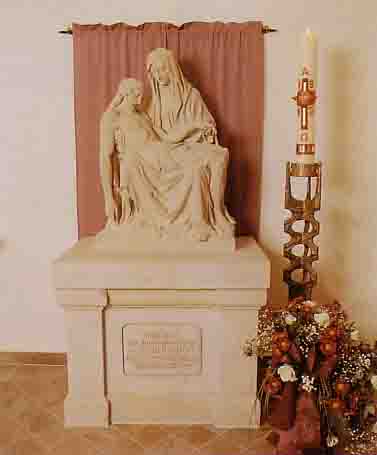
The
other sculptures of saints are arranged in secret places of work,
the place of work of Seling and the woodworker Fuchs.
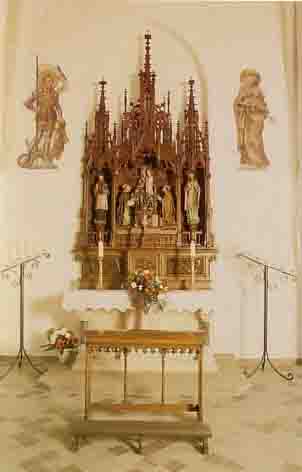 We
begin our observation of the most important works with the side
on the left inserted in a spiral niche in the wall. Two mural
paintings of saints frame it, at left Saint George, who holds
the dragon he has kidded in his right hand and on the right is
Saint Elisabeth. In the middle of the altar shrine stands the
Madonna of the rosary with the standing Child Jesus on her lap. We
begin our observation of the most important works with the side
on the left inserted in a spiral niche in the wall. Two mural
paintings of saints frame it, at left Saint George, who holds
the dragon he has kidded in his right hand and on the right is
Saint Elisabeth. In the middle of the altar shrine stands the
Madonna of the rosary with the standing Child Jesus on her lap.
In
the break through of the side name we find the patron saint of
the church, St. Servatius. He is one of the “Ice Saints”
and was Bishop of Maastricht in the Netherlands in the 4th century.
Because of St. Servatius’ efforts for peace, Peter is said
to have appeared to him and handed him a silver key with which
he could open eternal life to all that ask for it. This statue
shows him as a bishop with the key.
The
new gothic chancel, as well as the choir seats are not made in
color. At the chancel curb under the gothic multiple work windows
are the busts of the evangelists represented with their symbols.
A powerful multiple filigreed spire crowns the sounding board,
ending in a double flower cross.
The
old main altar shows a narrow case for the Eucharist – while
at the left of the tabernacle the Wedding at Canna is represented,
and to the right is shown the miracle of the loaves. The choir
windows show in beautiful colors from the lest to the right Mary
as comforter of the grieving ones, the crucifixion and the relatively
rare representation of Jesus with the disciples of Emmaus, and
how they recognized Him at the breaking of the bread. The large
scene over the right choir seats, which for us now appears somewhat
theatrical, shows the Sermon on the Mount. Forward is a statue
of the Sacred Heart that was created in 1915 by wood sculptor
Fuchs from Munich.
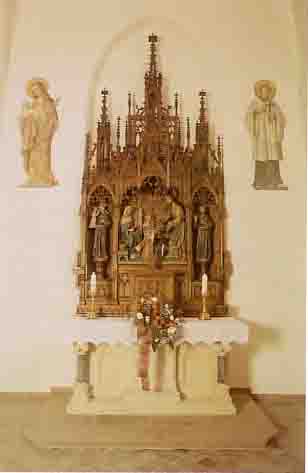 On
the right entrance to the side name we arrive at the right side
altar; it is devoted to the Holy Family, it shows very realistically
the carpenter’s workplace of Saint Joseph. Finally both
the statures at the middle pillars are to be mentioned; the first
apostle Peter with keys and Paul with the sword. The view back
shows us the powerful organ – here also is the new gothic
formation remaining of the time around 1900. The organ controls
over 15 registers and was constructed by the organ building company
Haupt in Osnabrück. On
the right entrance to the side name we arrive at the right side
altar; it is devoted to the Holy Family, it shows very realistically
the carpenter’s workplace of Saint Joseph. Finally both
the statures at the middle pillars are to be mentioned; the first
apostle Peter with keys and Paul with the sword. The view back
shows us the powerful organ – here also is the new gothic
formation remaining of the time around 1900. The organ controls
over 15 registers and was constructed by the organ building company
Haupt in Osnabrück.
When
leaving the church by the south portal (Berger side) we find the
life-large Crucifixion carved from sandstone around 1900 as mission
cross in front of the former western retaining wall. The eastern
retaining wall behind the Cross and the Sacristy extension of
1989/90 which breaks through of stairs, leads us to the War Memorial.
The worthy, park-like path with a fine view over the village leads
us to three war memorials, which show the rapid change of style
clear in the last hundred years. The eagle-crowned column of the
monument for 1870/71 is kept in historicism still whole, while
the memorial place for the fallen of World War I exhibits expressionist
style. The stairs and the part of the churchyard turned into a
memorial place for the fallen of World War II is in the new realistic
style. With the view of the beautiful silhouette of the neighboring
Lutheran church we can end our tour.
Explanation for the floor plan:
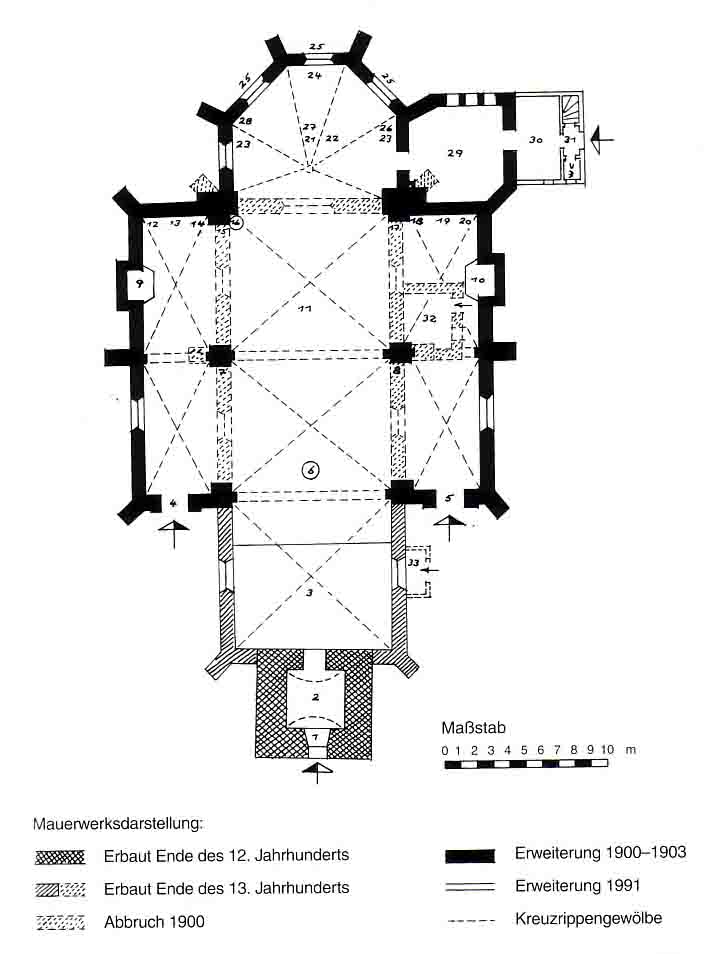
1.
Tower entrance (Entry)
2. Prayer chapel with Pieta
3. Organ loft
4. North Portal (Antener side)
5. South portal (Berger side)
6. Baptismal font (Bentheimer Type from about 1200)
7. St. Peter (statue)
8. St. Paul (statue)
9. Confession room (Antener side)
10. Confession room (Berger side)
11. Former choir area with ceiling fresco (15th century)
12. St. George (wall painting)
13. Blessed Virgin altar
14. St. Elisabeth (wall painting)
15. St. Servatius (church patron)
16. Chancel with reliefs of the four evangelists
17. Sacred Heart (statue – 1915)
18. St. Agnes (wall painting)
19. St. Joseph altar
20. St. Aloysius (wall painting)
21. New celebration altar (Sandstone from Mainfranken)
22. Ambo (reading desk – Sandstone from Mainfranken)
23. Old choir seat
24. Old high altar with tabernacle
25. Three beautiful colored glass choir windows
26. Large wall painting “Sermon on the Mount”
27. Seat for the priest
28. Old eternal light burner
29. Sacristy addition – 1990
30. Porch with toilet and basement steps
31. Old sacristy until 1900
32. Entrance porch until 1900
0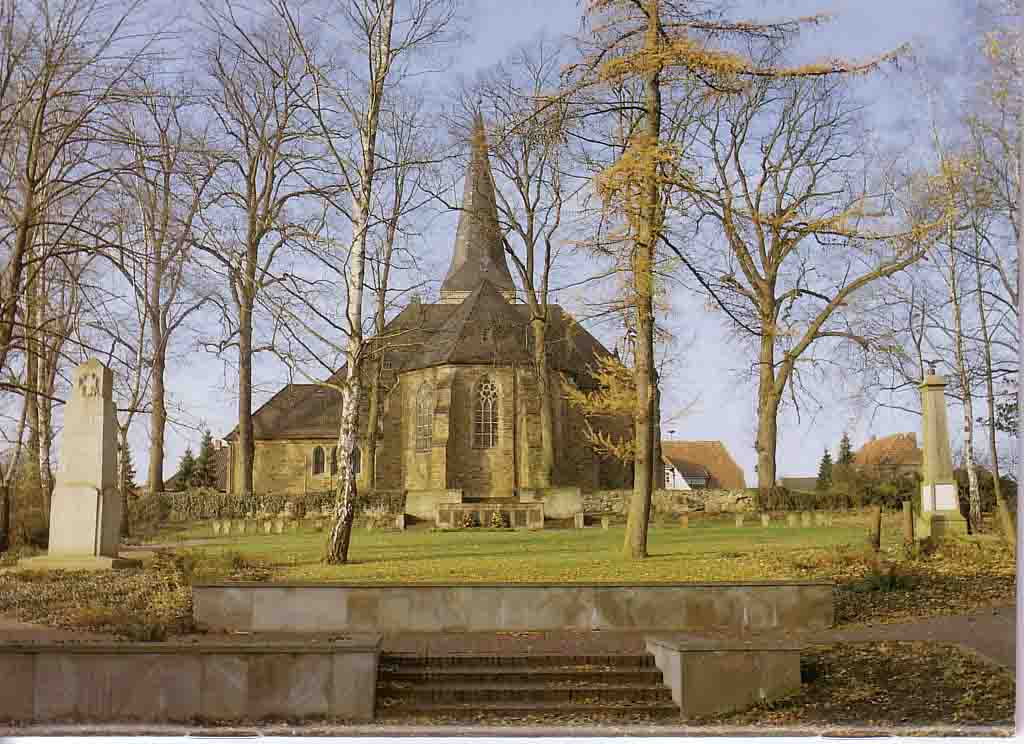
|